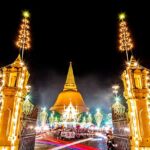
Nestled in the heart of Thailand lies a historical gem, Prasat Muang Tam, an architectural wonder shrouded in mystery and beauty. This ancient sanctuary stands as a testament to the rich cultural heritage and architectural prowess of the Khmer Empire, leaving visitors mesmerized by its intricate design and enigmatic past.
Origins and Historical Significance
Prasat Muang Tam, meaning “The Temple of the Ancient City,” is a breathtaking temple complex dating back to the 10th to 11th centuries CE, during the reign of the Khmer Empire. In Buriram province, it was a religious sanctuary dedicated to the Hindu god Shiva, typical in Khmer temples.
The temple’s significance lies not only in its religious purposes but also in its architectural brilliance. Constructed primarily from sandstone, the intricate carvings, detailed bas-reliefs, and the meticulous layout highlight the Khmer Empire’s mastery in design and construction.
Architectural Marvels
Prasat Muang Tam distinguishes itself with a unique architectural layout, differing from the renowned Angkor Wat style. Additionally, Mount Meru’s representation encircles a central pond, symbolizing the mythical Lake Anavatapta within the temple complex.
The main sanctuary, featuring five towers resembling lotus buds, stands prominently at the center of the complex. Each tower represents Mount Meru and signifies a connection between the earthly realm and the divine.

Moreover, the intricate bas-reliefs adorning the walls narrate tales from Hindu mythology and daily life during the Khmer period. Carvings depict gods, mythical creatures, daily scenes, offering insights into Khmer civilization’s culture and beliefs.
Mystery and Intrigue
Despite decades of research and restoration efforts, undisclosed secrets await revelation within Prasat Muang Tam’s confines. Its unique layout’s purpose and choice of location for construction remain topics sparking scholarly debate.
Some theories suggest the temple’s design linked to astronomy or royal ceremonies; others connect it to religious rituals with nearby springs.
The mystery surrounding Prasat Muang Tam beckons historians, archaeologists, and travelers, compelling them to delve into its enigmatic past.
Preservation Efforts and Tourism
Preserving Prasat Muang Tam for future generations is paramount. Consequently, the Thai government and global organizations restore and conserve this cultural treasure.
While Prasat Muang Tam may not attract the same influx of tourists as Angkor Wat, its serene ambiance and the sense of stepping into a hidden world captivate those who venture to explore its grounds. Visitors can marvel at the intricate architecture, stroll through the atmospheric ruins, and immerse themselves in the mystical aura of this ancient sanctuary.
Conclusion
Prasat Muang Tam stands as a testament to the ingenuity and cultural richness of the Khmer civilization. Its architectural grandeur, coupled with the air of mystery that surrounds it, continues to captivate scholars, historians, and travelers alike.
Gazing upon its weathered stones and intricate carvings transports us back in time, allowing us to imagine the vibrant rituals and beliefs that once echoed through its hallowed halls.Prasat Muang Tam remains an emblem of the Khmer Empire’s legacy, inviting us to unravel the mysteries concealed within its ancient walls and appreciate the profound beauty of our shared human history.
Additionally, let’s continue to Phanom Rung Castle , which is in the same area of the province.
More pictures here










